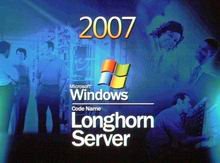Network Access Protection for Windows Server “Longhorn”
Network Access Protection for Windows Server “Longhorn”
Network Access Protection (NAP) is a policy enforcement  platform built into the Microsoft Windows Vista and Windows Server code name "Longhorn" operating systems that allows you to better protect network assets by enforcing compliance with system health requirements. With Network Access Protection, you can create customized health policies to validate computer health before allowing access or communication, automatically update compliant computers to ensure ongoing compliance, and optionally confine noncompliant computers to a restricted network until they become compliant.
platform built into the Microsoft Windows Vista and Windows Server code name "Longhorn" operating systems that allows you to better protect network assets by enforcing compliance with system health requirements. With Network Access Protection, you can create customized health policies to validate computer health before allowing access or communication, automatically update compliant computers to ensure ongoing compliance, and optionally confine noncompliant computers to a restricted network until they become compliant.
Network Access Protection includes an application programming interface (API) set for developers and vendors to create complete solutions for health policy validation, network access limitation, and ongoing health compliance.
To validate access to a network based on system health, a network infrastructure needs to provide the following areas of functionality:
Scenarios for Network Access Protection
•Internet Protocol security (IPsec) for host based authentication
Administrators can use these technologies separately or together to limit noncompliant computers. Network Policy Server (NPS), the replacement for Internet Authentication Service (IAS) in Windows Server 2003 in Windows Server "Longhorn," acts as a health policy server for all of these technologies.
Network Access Protection requires servers to run Windows Server "Longhorn" and clients to run Windows Vista, Windows XP with Service Pack 2 (SP2), or Windows Server "Longhorn."
IPsec Enforcement
IPsec Enforcement comprises a health certificate server and an IPsec NAP Enforcement Client (EC). The health certificate server issues X.509 certificates to quarantine clients when they are determined to be compliant. These certificates are then used to authenticate NAP clients when they initiate IPsec-secured communications with other NAP clients on an intranet.
IPsec Enforcement confines the communication on your network to those nodes that are considered compliant and because it is leveraging IPsec, you can define requirements for secure communications with compliant clients on a per-IP address or per-TCP/UDP port number basis. IPsec Enforcement confines communication to compliant computers after they have successfully connected and obtained a valid IP address configuration. IPsec Enforcement is the strongest form of limited network access in Network Access Protection.
802.1X Enforcement
802.1X Enforcement comprises an NPS server and an EAPHost NAP EC component. Using 802.1X Enforcement, an NPS server instructs an 802.1X access point (an Ethernet switch or a wireless access point) to place a restricted access profile on the 802.1X client until it performs a set of remediation functions. A restricted access profile can consist of a set of IP packet filters or a virtual LAN (VLAN) identifier to confine the traffic of an 802.1X client. 802.1X Enforcement provides strong limited network access for all computers accessing the network through an 802.1X connection.
VPN Enforcement
VPN Enforcement comprises a VPN NAP Enforcement Server (ES) component and a VPN NAP EC component. Using VPN Enforcement, VPN servers can enforce health policy requirements any time a computer attempts to make a VPN connection to the network. VPN Enforcement provides strong limited network access for all computers accessing the network through a VPN connection.
DHCP Enforcement
DHCP Enforcement comprises a DHCP NAP ES component and a DHCP NAP EC component. Using DHCP Enforcement, DHCP servers can enforce health policy requirements any time a computer attempts to lease or renew an IP address configuration on the network. DHCP Enforcement is the easiest enforcement to deploy because all DHCP client computers must lease IP addresses. Because DHCP Enforcement relies on entries in the IP routing table, it is the weakest form of limited network access in Network Access Protection.
NPS/RADIUS
The Remote Authentication Dial-In User Service (RADIUS) component of Windows Server "Longhorn," NPS, does not have a NAP ES or NAP EC component. Instead, it works as a policy server in conjunction with NAP ES and NAP EC components. Administrators must define system health requirements in the form of policies on the NPS server. NPS servers provide health policy checks and coordinate with the Active Directory® directory service any time a computer attempts to obtain a health certificate or to connect to an 802.1X access point, a VPN server, or a DHCP server.
No comments:
Post a Comment